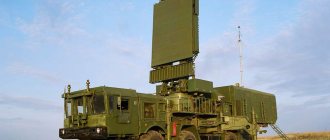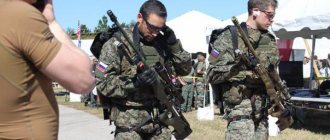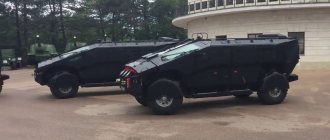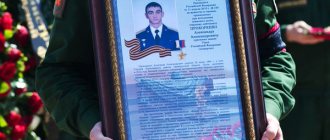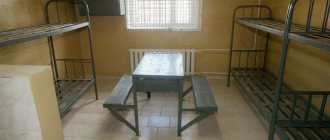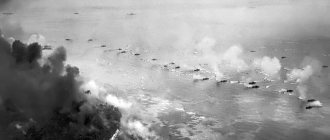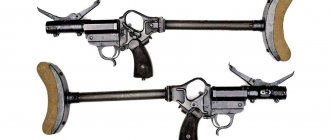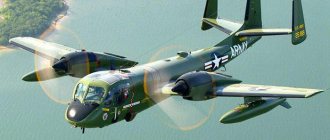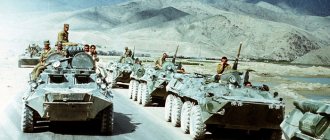Main characteristics
PRP-5 is designed to conduct reconnaissance of enemy targets and correct ground artillery fire in any weather conditions. The vehicle is built on a modular principle: it can be tracked or wheeled, the main option is the BTR-82 base. Its weight reaches 15500 kg. The armor can withstand hits from 12.7 mm ammunition “in the forehead”; the side and rear can withstand 7.62 mm bullets. Length - 7600 mm, width - 2993 mm, height - 2450 mm. Engine power - 300 l. With. The maximum speed on the highway is 100 km/h. The speed when overcoming water obstacles afloat is 10 km/h. Cruising range on the highway is 800 km. The main weapon is a remote-controlled combat module with a 12.7 mm machine gun. The vehicle is equipped with a navigation system, and also received optical-electronic suppression equipment to warn of laser irradiation and protection from elements of precision weapons through the creation of aerosol curtains.
Infantry fighting vehicles
Infantry fighting vehicles
BMP-1 infantry fighting vehicle
The world's first production infantry fighting vehicle. It was created as part of the concept of increasing the mobility and protection of infantry operating in conjunction with tanks. Developed at KB ChTZ. Adopted by the Soviet Army in 1966. Serially produced at KMZ from 1966 to 1983.
BMP-1 (1966)
BMP-1D
Serial modifications:
BMP-1 (object 765) - basic version. Special chassis with a front-mounted power compartment. Welded box-section body with side niches. At the rear of the hull there are entrance hatches, closed by doors with fuel tanks built into them. Conical welded turret with a coaxial installation of a 73-mm smoothbore cannon and a PKT machine gun. Semi-automatic loading mechanism, the conveyor of which contains ammunition. The Malyutka PU ATGM bracket is installed on the movable armor of the gun. The landing force can fire through embrasures in the sides of the hull. Movement afloat is due to rewinding the tracks. Serial production from 1966 to 1979. During the production process, changes were made to the design of the BMP aimed at increasing the reliability of the chassis, power plant, transmission, etc. Since 1973, a high-explosive fragmentation shot has been included in the ammunition load, and a 1PN22M2 sight has been installed. The vehicle is equipped with a traffic alarm system, and the loading mechanism was seized. Combat weight 13.2 tons.
BMP-1P (object 765Sp4) - the Malyutka ATGM system was seized. Instead, a launcher of the 9P135M complex for the 9M113 “Konkurs” ATGM or 9M135M-1 for the 9M111 “Fagot” ATGM with an ammunition load of 4 missiles is mounted on the roof of the tower. Lining and overlining have been introduced on the turret, hull, over-engine hatch, in the area where the driver’s feet are located, and on the commander’s and driver’s hatch covers. A napalm protection system has been installed. At the stern of the turret there are 6 smoke grenade launchers of the 902B “Tucha” system. Some of the vehicles were equipped with a KMT-10 rutted knife trawl. Combat weight 13.4 tons. Serial production from 1979 to 1983.
BMP-1PG - on the roof of the turret on the right is the installation of an AGS-17 “Flame” automatic grenade launcher. Some of the vehicles were re-equipped at tank repair plants.
BMP-1D (1982) - BMP-1 with reinforced armor (“Afghan” version). Steel side screens on the hull and an armor plate under the commander’s and driver’s workstations. Doesn't float.
BMP-1KSh (1972) - command and staff vehicle for motorized rifle and tank regiments. Instead of a cannon and a coaxial machine gun, a telescopic antenna-mast device is installed in the turret. In addition to the radio stations R-123MT, R-130M and R-111, the vehicle is equipped with telephone and telegraph communication equipment and a gas-electric unit. Combat weight 13 tons. Crew 7 people. Serial production since 1976.
PRP-3 "Val" (object 767, 1970) - a mobile reconnaissance point. A means of providing target designation to missile and artillery systems. Armament: PKT and PU 2P130-1 machine gun for firing illumination shells.
PRP-4 - created on the basis of PRP-3 and equipped with optical, electro-optical, thermal imaging and active-pulse night vision devices, radar equipment and means of processing and transmitting information. Weapon: PKT machine gun. Crew 5 people
PRP-4M (1988) - created on the basis of PRP-4 and equipped with a thermal imaging device and a 1D14 periscope laser rangefinder with improved characteristics. A portable 1D13 laser reconnaissance device was additionally introduced into the remote observation post.
BMP-1 (1970)
BMP-1 P
PRP-3 "Val"
BMP-1KSh
BMP-1 infantry fighting vehicles entered service with motorized rifle units of the Soviet Army ground forces.
It is not possible to indicate the exact number of vehicles of this type produced. Under Soviet license, BMP-1s were produced in Czechoslovakia (BVP-1), Poland, Romania (MLI-84) and India. In China, a copy of the BMP-1 is produced in small quantities under the symbol WZ-501.
The BMP-1 received its baptism of fire during the 1973 Arab-Israeli war. Three years later, they were used by Angolan and Cuban units in battles with South African troops. In 1982, the Syrian army used them in battles with Israeli troops in Lebanon. Libyan BMP-1s fought in Chad, and Indian ones fought against Tamil rebels in Sri Lanka. The Soviet Army used the BMP-1, BMP-1D and BMP-1 P during military operations in Afghanistan.
After the unification of Germany, the BMP-1, among the few examples of Soviet military equipment, was temporarily adopted by the Bundeswehr under the designation BMP-1A1 “Ost”. A number of changes were made to its design in order to bring the vehicle’s performance characteristics closer to NATO standards.
As of 1995, BMP-1 infantry fighting vehicles were in service in Algeria (684 units), Angola, Afghanistan, Bulgaria, Hungary (502), Vietnam (400), Greece (500, received from Germany), Egypt (200) , Iraq, Iran (200), India, Yemen (150), China, North Korea, Cuba, Libya (740), Poland (1680), Slovakia (311), Syria (2300), Finland (40), Czech Republic (605) , Sweden (300, received from Germany), Sri Lanka, Ethiopia (20).
BMP-1s were used by warring parties in almost all armed conflicts on the territory of the former USSR. The Russian Army and the internal troops of the Ministry of Internal Affairs of the Russian Federation have used and are using these vehicles during anti-terrorist operations in Chechnya.
Based on the BMP-1, command vehicles BMP-1 K and BMP-1 PK, armored repair and recovery vehicles BREM-2 and BREM-4, the combat reconnaissance vehicle BRM-1K, the engineering reconnaissance vehicle IRM "Zhuk" and others were produced.
TACTICAL AND TECHNICAL CHARACTERISTICS OF BMP-1
COMBAT WEIGHT, t: 13.
CREW, people: 3.
LANDING, people: 8.
OVERALL DIMENSIONS, mm: length - 6735, width - 2940, height - 2068, ground clearance - 370.
ARMAMENT: 1 2A28 "Grom" cannon of 73 mm caliber, 1 9M14M "Malyutka" ATGM complex, 1 PKT machine gun of 7.62 mm caliber, 1 MANPADS 9K32 "Strela-2" (instead of MANPADS, the vehicle could carry an RPG-7 grenade launcher).
AMMUNITION: 40 rounds, 4 ATGMs, 2000 rounds.
CHARGING MECHANISM: electromechanical.
AIMING DEVICES: periscope combined (day and night) unilluminated sight 1PN22M1.
RESERVATION, mm: 6 -26.
ENGINE: UTD-20, 6-cylinder, four-stroke, V-shaped, compressor-free liquid-cooled diesel engine with jet fuel atomization; power 300 hp (220.8 kW) at 2600 rpm; working volume 15,800 cm.
TRANSMISSION: multi-disc main dry friction clutch, five-speed manual gearbox, planetary two-stage turning mechanisms, planetary single-stage final drives.
CHASSIS: six single rubber-coated support rollers on board, three rubber-coated support rollers, a front drive wheel with removable ring gears (lantern engagement), a guide wheel; individual torsion bar suspension, hydraulic shock absorbers in the suspensions of the 1st and 6th rollers; each caterpillar has 84 tracks 300 mm wide, track pitch 140 mm.
MAX. SPEED, km/h: on the highway - 65, afloat - 7.
POWER RESERVE, km: 600.
OBSTACLES TO OVERCOME: ascent angle, degrees. - 35; ditch width, m - 2.5; wall height, m - 0.7.
COMMUNICATIONS: radio station R-123M, intercom R-124.
BMP-2 infantry fighting vehicle
Created on the basis of the BMP-1 to further improve combat performance. It was developed at the ChTZ Design Bureau since 1972 (object 769) and at the KMZ Design Bureau since 1974 (objects 680 and 675). Adopted by the Decree of the USSR Council of Ministers in August 1980. Serial production at KMZ since April 1980.
Serial modifications:
BMP-2 (object 675) - the general layout is similar to the BMP-1. In the bow of the hull on the right there is a logistics compartment, on the left there is a control compartment, in the middle part of the vehicle there is a fighting compartment, and in the stern there is a landing compartment. The tower is welded, conical, double. The gun's power supply system is a two-belt system, which allows you to quickly change the type of projectile - armor-piercing or fragmentation - depending on the nature of the target. The gun elevation angle is 74°, firing at air targets can be carried out at altitudes up to 2000 m. Movement afloat is due to rewinding tracks. The BMP is equipped with PAZ, PPO and protection systems against neutron weapons (top and bottom). On some vehicles, an automatic 30-mm AGS-17 grenade launcher is installed on the turret in an armored casing.
BMP-2D (1982) - reinforced armor (“Afghan” version). Steel side screens on the hull and an armor plate under the commander’s and driver’s workstations. Combat weight 14.5 tons. Does not float.
BMP-2
BMP-2D
In April 1980, the first 25 BMP-2s were sent to Afghanistan, where their baptism of fire took place. Until the withdrawal of Soviet troops from this country in 1989, BMP-2 and BMP-2D (“D” - airborne, this vehicle entered service with the airborne assault units of the Airborne Forces) were successfully used by our troops.
In the 80s, BMP-2 entered service with the Warsaw Pact member countries. Under Soviet license, production of the vehicle was launched in Czechoslovakia.
As of 1995, BMP-2s were in service in Algeria (230 units), Afghanistan, India, Iraq, Kuwait, Slovakia (93), Finland (110), Czech Republic (187), and Sri Lanka.
BMP-2 took part in the Iran-Iraq war. Iraqi forces also used these vehicles against allied forces during Operation Desert Storm. “Twos” fought and are fighting in almost all “hot spots” in Russia and the CIS, including Tajikistan and Chechnya.
Based on the BMP-2, the BMP-2K command vehicle is mass-produced.
TACTICAL AND TECHNICAL CHARACTERISTICS OF BMP-2
COMBAT WEIGHT, t: 14.
CREW, people: 3.
LANDING, people: 7.
OVERALL DIMENSIONS, mm: length - 6735, width - 3150, height - 2450, ground clearance - 420.
ARMAMENT: 1 2A42 automatic cannon of 30 mm caliber, 1 launcher of the 9P135M complex for the 9M113 “Konkurs” ATGM or 9M135M-1 for the 9M111 “Fagot” ATGM, 1 PKT machine gun of 7.62 mm caliber, 2 9K34 “Strela-3” MANPADS (instead of MANPADS in the vehicle can accommodate two RPG-7 grenade launchers), 6 smoke grenade launchers of the 902V “Tucha” system.
AMMUNITION: 500 rounds (160 BT, 340 OFZ and OT), 4 ATGMs, 2000 rounds.
WEAPONS STABILIZER: electromechanical two-plane 2E36-1.
AIMING DEVICES: binocular combined (day, active-passive night) sight BPK-1-42. RESERVATION, mm: 6 - 26.
ENGINE: UTD-20S1, 6-cylinder, four-stroke, V-shaped, compressor-free, liquid-cooled diesel engine with jet fuel atomization; power 300 hp (220.8 kW) at 2600 rpm; working volume 15,800 cm?.
TRANSMISSION: multi-disc main dry friction clutch, five-speed manual gearbox, planetary two-stage turning mechanisms, planetary single-stage final drives.
CHASSIS: six single rubber-coated support rollers on board, three rubber-coated support rollers, a front drive wheel with removable ring gears (lantern engagement), a guide wheel; individual torsion bar suspension, hydraulic shock absorbers in the suspensions of the 1st, 2nd and 6th rollers; each caterpillar has 85 tracks 300 mm wide, track pitch 140 mm.
MAX. SPEED, km/h: on the highway - 65, afloat - 7.
POWER RESERVE, km: 600.
OBSTACLES TO OVERCOME: ascent angle, degrees. - 35; ditch width, m - 2.5; wall height, m - 0.7.
COMMUNICATIONS: radio station R-123M, intercom R-124.
BMP-3 infantry fighting vehicle
Created in the early 80s at the KMZ Design Bureau using elements of the chassis of a light amphibious tank (object 685). Entered service in 1987. It is in serial production at KMZ.
Serial modification:
The body is welded, made of aluminum and steel alloy. The conical welded double turret contains a built-in weapons unit—two cannons and a machine gun. Two more machine guns are located in the bow-mounted autonomous installations, equipped with devices with a fiber-optic system for displaying the aiming mark. Movement afloat is carried out using auger-type water-jet propulsors or rewinding tracks. PAZ system, TDA, smoke grenade launch system, PPO, self-entrenchment equipment.
In terms of its tactical and technical characteristics, mainly in terms of the power of the weapons installed on it, the BMP-3 is significantly superior to all known infantry fighting vehicles of foreign armies.
The BMP-3 is in service with the Russian Army, as well as the armies of the United Arab Emirates (415 units in 1999), Cyprus (43), Kuwait (55) and South Korea (40). In the export version, the vehicle is equipped with air conditioning and a French-made Athos thermal imaging sight.
Based on the BMP-3, the BMP-ZK command vehicle, the BRM-3 “Lynx” combat reconnaissance vehicle, the BREM-L “Beglyanka” armored repair and recovery vehicle (object 691), the 2S31 “Vena” self-propelled gun and a universal chassis for mounting various types were created weapons.
BMP-3
TACTICAL AND TECHNICAL CHARACTERISTICS OF BMP-3
COMBAT WEIGHT, t: 18.7.
CREW, people: 3.
LANDING, people: 7.
OVERALL DIMENSIONS, mm: length - 7200, width - 3230, height - 2450, ground clearance -450.
ARMAMENT: 1 2A70 cannon of 100 mm caliber, 1 automatic cannon 2A72 of 30 mm caliber, 3 PKT machine guns of 7.62 mm caliber, 6 launchers of 81 mm caliber for launching smoke grenades.
AMMUNITION: 40 rounds (22 of them in the loading mechanism) of 100 mm caliber, 500 rounds of 30 mm caliber, 6000 rounds.
CHARGING MECHANISM: electromechanical.
WEAPONS STABILIZER: two-plane electric 2E52-2.
GUIDED WEAPONS COMPLEX: 9K116 “Bastion” with 9M117 TUR with laser beam control.
AIMING DEVICES: laser rangefinder 1D16, gunner-operator sighting device 1K13-2, gunner-operator sight for firing at air and ground targets (optional) PPB-2, commander's sight for firing at air and ground targets 1PZ-10.
RESERVATION, mm: bulletproof.
ENGINE: UTD-29, 10-cylinder, four-stroke, V-shaped, multi-fuel liquid-cooled diesel engine; power 500 hp (368 kW) at 2600 rpm.
TRANSMISSION: hydromechanical four-speed (4+2), with a hydrodynamic transformer, hydrostatic turning mechanism and drive to water jets, final drives.
CHASSIS: six double rubberized support rollers on board, three single rubberized support rollers, rear drive wheel with removable ring gears (lantern engagement), guide wheel; individual torsion bar suspension, hydraulic shock absorbers in the suspensions of the 1st, 2nd and 6th rollers; each caterpillar has 88 tracks 380 mm wide, track pitch 150 mm.
MAX. SPEED, km/h: on the highway - 70, afloat - 10.
POWER RESERVE, km: 650.
OBSTACLES TO OVERCOME: ascent angle, degrees. - 35; ditch width, m - 2.5; wall height, m - 0.8.
COMMUNICATIONS: radio station R-173, intercom R-174.
Full automatic
PRP-5 is a complex of television, thermal imaging, and radar reconnaissance equipment combined into a single system. According to the manufacturer, this should increase the information content of the received intelligence data. Primary processing of information occurs automatically; it is clearly displayed on an electronic map of the area with the tactical situation plotted. High degree of automation is the main advantage of this machine. The control computer has an intuitive interface that “suggests” options for solving assigned reconnaissance tasks. There is an option to automatically transfer reconnaissance information to the fire control command post.
Notes[ | ]
- ↑ 1 2 3
Mobile reconnaissance point PRP-4
(unspecified)
(inaccessible link). Access date: February 18, 2012. Archived February 11, 2012. - ↑ 1 2 3 4 A.V.
Karpenko , Review of domestic armored vehicles (1905-1995), p. 133 - Award to the creators of "Argus" Arsenal of the Fatherland
, 02/06/2017 - Lensky A. G., Tsybin M. M.
Soviet ground forces in the last year of the USSR. - St. Petersburg: B&K, 2001. - P. 27-30. — 294 p. — ISBN 5-93414-063-9.
I sit high, I look far away
Visually, the main difference of this special vehicle is the telescopic antenna, which raises optical and radar reconnaissance equipment to a height of up to 6 meters. It is also possible to conduct surveillance in the optical range without deploying a mast.
What kind of projectile to protect armored vehicles from high-precision weapons will appear in the Russian Federation? More details
The equipment set includes a remote observation post, which includes the Strelets reconnaissance, control and communications complex, a 24-hour portable reconnaissance device, as well as an aerial reconnaissance complex (short-range drone equipped with video and thermal imaging cameras for surveillance in day and night conditions ).
Technologies
The manufacturer claims that the PRP-5 is a modern reconnaissance system, which in its tactical and technical characteristics is not inferior to its foreign counterparts. To meet high standards, it has a rich set of tools. The vehicle is equipped with an optical-electronic reconnaissance device, which includes a high-definition television channel, a thermal imaging channel and a laser range finder. The equipment set also includes a radar station for reconnaissance of ground moving targets with a phased array antenna. There is also a powerful information and computing system that processes data from all sources. A set of communication and data transmission means allows you to work in an automated control system.
